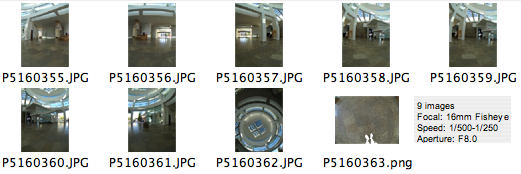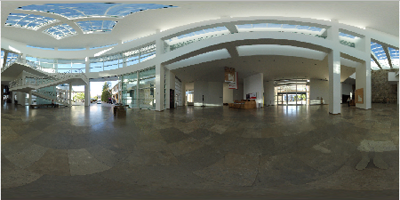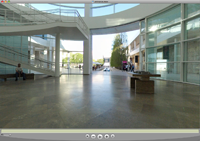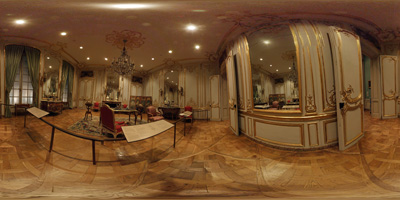| Generally, museums are built to hold artwork like this [Irises by Vincent Van Gogh, Getty Museum, Los Angeles.] One reason why I like the Getty is that it's a destination in itself. |

|
Cool architecture:

Out of the LA basin:

with a panoramic view of LA:

A stitched panorama of LA. (Only time I managed to use a tripod. More on that in a moment.) Air pollution (haze) limited the clarity of the image.
You can see the how sprawled out LA is (hard to believe 10 million people live here), the Pacific Ocean, downtown, UCLA and so on.)

A cooler place to hang out than down in LA - well, except it can still get very hot in the sun...

Anyway, I wanted to take some 360° spherical panoramas while I was there. I usually take these using a panoramic head and tripod for precise rotation and image stitching. (See my equipment and a previous project MIT Stata Center.) Unfortunately, the Getty museum doesn't allow the use of tripods, inside or OUTSIDE. Museum staff quickly descended on me each time I tried to take my tripod out. So unfortunately, I had to shoot these handheld using a laser pointer and a spirit level to approximate the precision of a panoramic head. (I'll cover handheld equipment in a future entry.) You'll need Quicktime to view the 360° movie files. I shot 7 pictures around, overlapping a bit more than my usual 60° per picture. One zenith and one nadir. (I masked out my feet in postprocessing using Photoshop Elements.)

I used Autopano Pro to stitch them together into this equirectangular projection:

| Pano2vr then produces a Quicktime Movie file that you can scroll around in. Click picture on the right to load the .mov file (10MB). Take a look up at the ceiling. |

|
Since no features were close to the camera, stitching errors are not apparent despite being handheld. No such luck in the next shot (click on picture to get the10.8MB .mov file):

As a result, I was surprised to get good stitching on this room shot (click to see 7.7MB .mov file):

Assembled from 6 shots around plus zenith and edited nadir:

